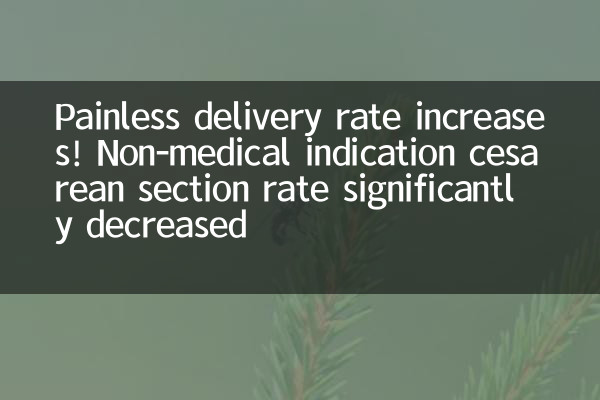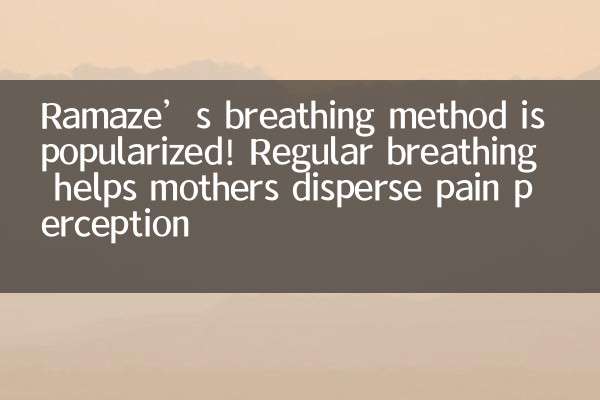The painless delivery rate increases! Non-medical indication cesarean section rate significantly decreased
In recent years, with the advancement of medical technology and the renewal of childbirth concepts, my country's childbirth methods are undergoing positive changes. The latest data show that the rate of painless delivery has increased significantly, while the rate of cesarean section, which is not medically indicated, shows a significant downward trend. This change not only reflects the optimization of medical services, but also reflects the increased recognition of natural childbirth by pregnant women.
1. The painless childbirth rate continues to rise

The promotion and application of painless childbirth technology provides a more comfortable childbirth experience for pregnant women. According to the latest data released by the National Health Commission, the national painless delivery rate has increased from less than 10% in 2018 to more than 35% in 2023, and some developed regions even exceed 50%. The following are the changes in painless childbirth rates in the past five years:
| years | National painless childbirth rate | Painless childbirth rate in developed areas |
|---|---|---|
| 2018 | 9.7% | 15.2% |
| 2019 | 16.3% | 25.8% |
| 2020 | 22.1% | 35.6% |
| 2021 | 28.4% | 42.3% |
| 2022 | 32.7% | 48.9% |
| 2023 | 35.2% | 53.1% |
The improvement of this data is driven by the promotion of a number of policies, including the "Notice on Carrying out Pilot Analgesia for Childhood" issued by the National Health Commission in 2018, and the popularization and promotion of painless childbirth technology by medical institutions at all levels.
2. The rate of non-medical indications of cesarean section has decreased significantly
At the same time, the rate of cesarean section that is not medically indicated showed a significant downward trend. In the past, some pregnant women chose to have cesarean section due to fear of childbirth pain or other non-medical reasons. However, this phenomenon is changing with the popularity of painless childbirth and the strengthening of health education. The following are the changes in the rate of non-medical-indicated cesarean section in the past five years:
| years | National non-medical indication cesarean section rate | Non-medical indication of cesarean section rate in developed areas |
|---|---|---|
| 2018 | 25.6% | 18.3% |
| 2019 | 22.8% | 15.7% |
| 2020 | 20.1% | 13.2% |
| 2021 | 17.9% | 11.5% |
| 2022 | 15.4% | 9.8% |
| 2023 | 13.7% | 8.2% |
This change not only reduces the risk of surgery brought by cesarean section, but also promotes maternal and infant health. Natural childbirth has significant advantages in maternal recovery and the establishment of the infant's immune system.
3. The dual promotion of policy and education
The increase in painless delivery rate and the decline in non-medical-indicated cesarean section rate are inseparable from the joint efforts of policy support and health education. In recent years, the National Health Commission has jointly organized medical institutions at all levels to promote the optimization of childbirth through the following measures:
1.Pilot promotion: Starting from 2018, a pilot work of childbirth analgesia will be carried out nationwide, and the coverage of painless childbirth technology will be gradually expanded.
2.Talent training: Strengthen training for anesthesiologists and obstetricians to ensure the safety and popularity of painless childbirth technology.
3.Health education: Through pregnant women's schools, community publicity and other methods, popularize the knowledge of natural childbirth and painless childbirth, and reduce the fear of childbirth pain.
4.Medical Insurance Support: Some regions have included painless childbirth in the scope of medical insurance reimbursement, reducing the financial burden of pregnant women.
4. Future prospects
Although the changes in painless delivery rates and non-medical-indicated cesarean section rates are encouraging, my country still has room for improvement compared with developed countries. In the future, we need to further increase policy support and expand the coverage of painless childbirth technology, especially primary medical institutions. At the same time, we will continue to strengthen health education, help pregnant women establish scientific concepts of childbirth, and promote maternal and infant health.
In short, the increase in painless delivery rate and the decline in the rate of non-medical-indicated cesarean section mark a significant improvement in the quality of delivery services in my country. This trend will continue to bring a safer and more comfortable delivery experience to pregnant women.

check the details

check the details